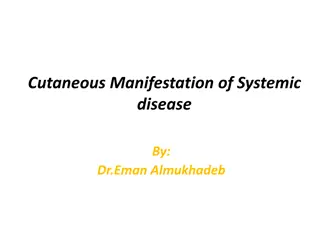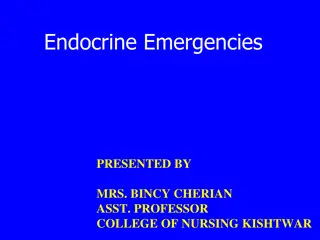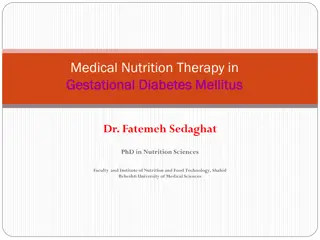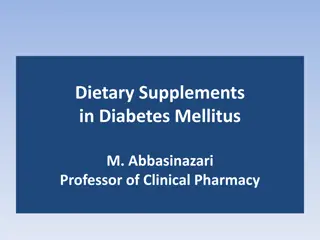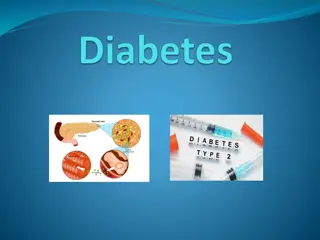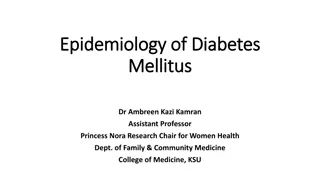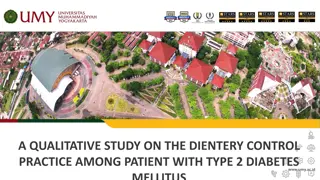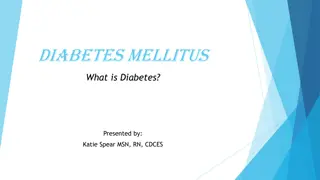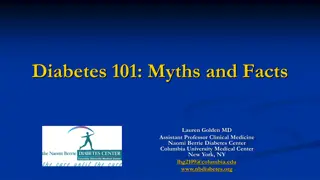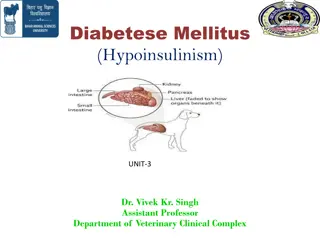Understanding Carbohydrate Metabolism and Diabetes Mellitus
Carbohydrates play a vital role in energy production through processes like glycolysis and gluconeogenesis. Glucose metabolism involves pathways like aerobic glycolysis and anaerobic lactate production. In diabetes mellitus, there is a disruption in carbohydrate metabolism leading to elevated blood glucose levels. This condition can have severe consequences like end-stage renal disease, amputations, and atherosclerosis. Understanding these processes is crucial for managing and preventing complications associated with diabetes.
Download Presentation

Please find below an Image/Link to download the presentation.
The content on the website is provided AS IS for your information and personal use only. It may not be sold, licensed, or shared on other websites without obtaining consent from the author. Download presentation by click this link. If you encounter any issues during the download, it is possible that the publisher has removed the file from their server.
E N D
Presentation Transcript
Carbohydrates lecture 2 F.I.C.M.S Path Dr. Ammar Hatem M.Sc. Zaenab M. Najem
Glucose metabolism Glycolysis is the sequence of reactions that converts glucose into pyruvate in the presence of oxygen (aerobic) or lactate in the absence of oxygen (anaerobic) with the production of ATP. It is a unique pathway since it can utilize oxygen if available, or it can function in the total absence of oxygen Location Glycolysis is the major pathway for the utilization of glucose and is found in cytosol of all cells.
Under aerobic condition pyruvate is taken up into mitochondria and after conversion to acetyl-CoA is oxidized to CO 2 and H2 O by citric acid cycle with production of ATP. Anaerobic Glycolysis Tissues that function under hypoxic conditions produce lactate, e.g. exercising skeletal muscle and erythrocytes. In erythrocytes even under aerobic conditions, glycolysis produce lactate because of absence of mitochondria.
Gluconeogenesis The synthesis of glucose from noncarbohydrate precursors is called gluconeogenesis Precursors for gluconeogenesis include: Lactate Glycerol Glucogenic amino acids Location of Gluconeogenesis Gluconeogenesis occurs mainly in the cytosol. Liver is the major tissue for gluconeogenesis. During starvation, the kidney is also capable of making glucose by gluconeogenesis.
Diabetes mellitus Diabetes mellitus is a group of diseases in which blood glucose levels are elevated. Diabetes is the most common disorder of carbohydrate metabolism Diabetes is the leading cause of end-stage renal disease non traumatic amputations, blindness. atherosclerotic disease. deaths
Pathophysiology Carbohydrates and glucose in particular are an important source of energy for most living organisms. What happens after a meal ? After carbohydrates digestion and absorption the blood glucose elevated which stimulates the pancreas to release insulin that facilitate glucose inertance inside the cells to use it as source of energy or in another metabolic processes
In diabetes mellitus, metabolism of all the main foodstuffs is altered. The basic effect on glucose metabolism is insulin deficiency or insulin resistance
Classification type 1 diabetes mellitus, which is caused by an absolute or near absolute deficiency of insulin, represents approximately 10% of all cases of diabetes. There usually is an autoimmune destruction of insulin- producing beta cells in the islets of the pancreas type 2 diabetes mellitus, which is characterized by the presence of insulin resistance with an inadequate compensatory increase in insulin secretion which usually end with relative or absolute deficiency in insulin secretion. Type 2 diabetes is the most common type of diabetes, affecting approximately 90% of cases. Many of them are obese
In addition, women who develop diabetes during their pregnancy are classified as having gestational diabetes. Specific types of diabetes which are caused by infections, drugs, endocrinopathies, and genetic defects.
Diagnosis of Diabetes Any of the followings tests is diagnostic to DM: Fasting blood glucose 126 Random blood glucose or 2 Hrs. post prandial blood glucose 200 mg/dl HbA1c 6.5% To confirm the diagnosis repeat the same test in different day
Glycated hemoglobin Glycated hemoglobin (HbA1c) is the term used to describe the formation of a hemoglobin compound produced when glucose reacts with the globin part of hemoglobin. HbA1c testing provides an index of average blood glucose levels over the past 2 to 4 months ( depending on RBC life span ) Conditions associated with shortened red blood cell survival such as hemolysis and pregnancy will lower the HbA1c level .
Thank you for your listening




